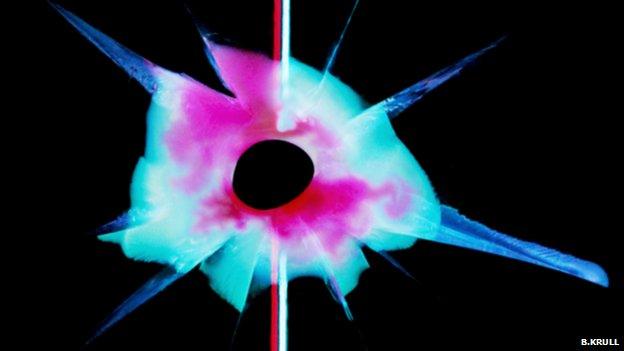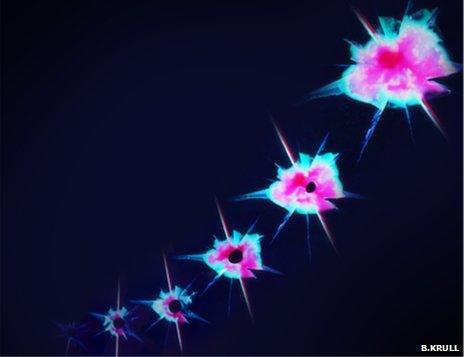Self-healing plastic mimics blood clotting
- Published

Healing chemicals arrive via capillaries (the red and blue vertical lines) and form a gel that seals the gap
A new plastic that "heals itself" has been designed, meaning your cracked phone screen or broken tennis racquet could mend its own wounds.
The polymer automatically patches holes 3cm wide, 100 times bigger than before.
Inspired by the human blood clotting system, it contains a network of capillaries that deliver healing chemicals to damaged areas.
The new material, created by engineers at the University of Illinois, is described in Science journal, external.
For decades scientists have dreamed of plastics that heal themselves like human skin.
Cracks in water pipes and car bonnets would seal up. Satellites could repair their own damage. Broken electronic chips in laptops and mobile phones would spontaneously sort out their own problems.

A timelapse of a broken area self-healing (left to right)
One of the first big breakthroughs came in 2001 at the University of Illinois, external. Prof Scott White and colleagues infused a polymer with microscopic capsules containing a liquid healing agent. When the material cracked, the chemicals were released and bridged the gaps.
More recently, concrete, water-resistant coatings, and even electrical circuits, external have been engineered with self-healing properties.
But even the best self-healing plastics and polymers can only repair small-scale damage, the Science magazine authors note.
"Although self-healing of microscopic defects has been demonstrated, the re-growth of material lost through catastrophic damage requires a regenerative-like approach," said Prof White.
To fix larger breakages, he and his team have designed a new, vascular system - inspired by the arteries and veins of the human body.
A network of channels delivers a healing agent to the site of damage.
The chemicals arrive via two separate streams. They combine to seal the gap in a two-stage reaction. Initially, they form a gel scaffold across the hole. The gel then slowly hardens into a robust, solid structure.
"We filled regions exceeding 35mm within 20 minutes, and restored mechanical function within three hours," the researchers wrote in Science.
Tests showed the material recovered about 62% of its original strength.
Self-healing systems

Capsules containing the healing agents and other chemicals are distributed throughout the material. If a breakage occurs, the capsules release their contents casuing a chemical reaction to "heal" the breakage.

Vascular systems use networks of refillable channels to deliver the healing agent and polymerisers to the breakage point.

Intrinsic systems use the reversible nature of certain chemical bonds to incorporate healing properties directly into the material.
The new material paves the way for future polymers that can recover from ballistic impacts, such as bullets, bombs or rockets.
Its design was praised by engineers Zhouzhou Zhao and Prof Ellen Arruda, of the University of Michigan.
"This innovative approach enables restoration of mechanical integrity to a damage volume that is roughly 100 times the largest defect previously healed in this manner," they wrote in Science, external.
"Vascular systems can potentially eliminate fracture in materials by preventing small, noncritical cracks from propagating to critical sizes."
However, future materials which are "truly regenerative" will require a much more flexible repair system, the scientists admit.
"When damage is unpredictable and uncontrolled, more complex and interconnected vascular networks will be necessary to provide sufficient vascular coverage and redundancy to circumvent channel blockage," Prof White and his co-authors wrote.
While recent advances in self-healing are exciting, "the long-term performance of autonomously healed polymers has largely remained unexamined," said Prof Arruda and Mr Zhao.
"Methods are also needed to assess and monitor the potential healing ability after multiple repair events.
"Here again, elegant examples that have evolved in nature can inspire solutions."